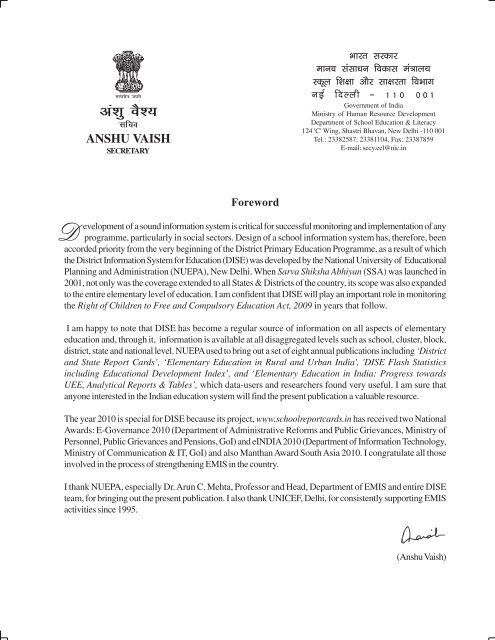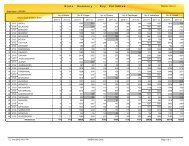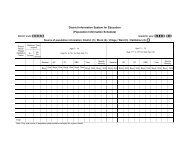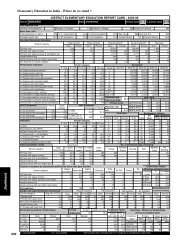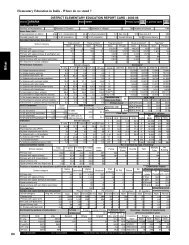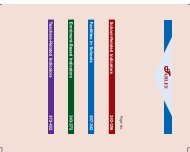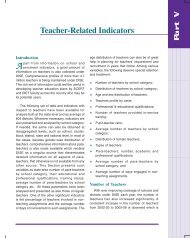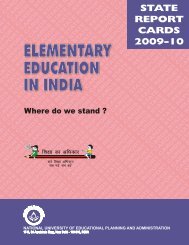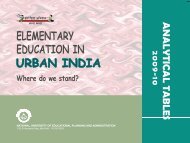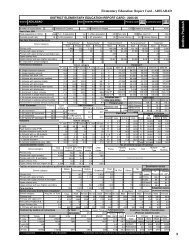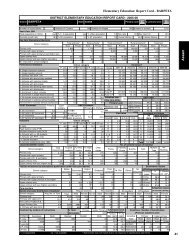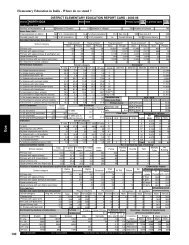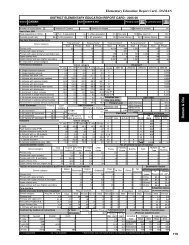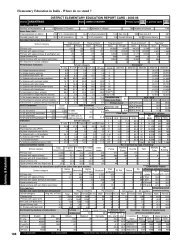- Page 3: Published by National University of
- Page 8 and 9: For the last several years, NUEPA h
- Page 10 and 11: Sch : School SCR : Student-Classroo
- Page 12 and 13: Munger 85 Muzaffarpur 86 Nalanda 87
- Page 14 and 15: Shimoga 266 Tumkur 267 Udupi 268 Ut
- Page 16 and 17: Jalandhar 448 Kapurthala 449 Ludhia
- Page 18 and 19: 1. Introduction Ever since its ince
- Page 20 and 21: collection system. However, a few s
- Page 22 and 23: 18. Student-Classroom Ratio (SCR) T
- Page 24 and 25: 5. Limitations of the Data Raw data
- Page 26 and 27: DISE 2008-09: Coverage Sl. School S
- Page 28 and 29: District BISHNUPUR State Manipur El
- Page 30 and 31: District CHURACHANDPUR State Manipu
- Page 32 and 33: District IMPHAL WEST State Manipur
- Page 34 and 35: District TAMENGLONG State Manipur E
- Page 36 and 37: District UKHRUL State Manipur Eleme
- Page 38 and 39: District EAST KHASI HILLS State Meg
- Page 40 and 41: District RI BHOI DISTRICT ELEMENTAR
- Page 42 and 43: District WEST GARO HILLS State Megh
- Page 44 and 45: District AIZAWL DISTRICT ELEMENTARY
- Page 46 and 47: District KOLASIB State Mizoram Elem
- Page 48 and 49: District LUNGLEI State Mizoram Elem
- Page 50 and 51: District SAIHA DISTRICT ELEMENTARY
- Page 52 and 53: District DIMAPUR State Nagaland Ele
- Page 54 and 55:
District KOHIMA State Nagaland Elem
- Page 56 and 57:
District MOKOKCHUNG State Nagaland
- Page 58 and 59:
District PEREN DISTRICT ELEMENTARY
- Page 60 and 61:
District TUENSANG State Nagaland El
- Page 62 and 63:
District ZUNHEBOTO State Nagaland E
- Page 64 and 65:
District BALASORE State Orissa Elem
- Page 66 and 67:
District BHADRAK State Orissa Eleme
- Page 68 and 69:
District BOUDH DISTRICT ELEMENTARY
- Page 70 and 71:
District DEOGARH State Orissa Eleme
- Page 72 and 73:
District GAJAPATI State Orissa Elem
- Page 74 and 75:
District JAGATSINGHPUR State Orissa
- Page 76 and 77:
District JHARSUGUDA State Orissa El
- Page 78 and 79:
District KANDHAMAL State Orissa Ele
- Page 80 and 81:
District KEONJHAR State Orissa Elem
- Page 82 and 83:
District KORAPUT State Orissa Eleme
- Page 84 and 85:
District MAYURBHANJ State Orissa El
- Page 86 and 87:
District NAYAGARH State Orissa Elem
- Page 88 and 89:
District PURI DISTRICT ELEMENTARY E
- Page 90 and 91:
District SAMBALPUR State Orissa Ele
- Page 92 and 93:
District SUNDARGARH State Orissa El
- Page 94 and 95:
District MAHE DISTRICT ELEMENTARY E
- Page 96 and 97:
District YANAM DISTRICT ELEMENTARY
- Page 98 and 99:
District BARNALA State Punjab Eleme
- Page 100 and 101:
District FARIDKOT State Punjab Elem
- Page 102 and 103:
District FIROZPUR State Punjab Elem
- Page 104 and 105:
District HOSHIARPUR State Punjab El
- Page 106 and 107:
District KAPURTHALA State Punjab El
- Page 108 and 109:
District MANSA DISTRICT ELEMENTARY
- Page 110 and 111:
District MOHALI State Punjab Elemen
- Page 112 and 113:
District NAWANSHAHR State Punjab El
- Page 114 and 115:
District RUPNAGAR State Punjab Elem
- Page 116 and 117:
District TARAN TARAN State Punjab E
- Page 118 and 119:
District ALWAR DISTRICT ELEMENTARY
- Page 120 and 121:
District BARAN DISTRICT ELEMENTARY
- Page 122 and 123:
District BHARATPUR State Rajasthan
- Page 124 and 125:
District BIKANER State Rajasthan El
- Page 126 and 127:
District CHITTAURGARH State Rajasth
- Page 128 and 129:
District DAUSA DISTRICT ELEMENTARY
- Page 130 and 131:
District DUNGARPUR State Rajasthan
- Page 132 and 133:
District HANUMANGARH State Rajastha
- Page 134 and 135:
District JAISALMER State Rajasthan
- Page 136 and 137:
District JHALAWAR State Rajasthan E
- Page 138 and 139:
District JODHPUR State Rajasthan El
- Page 140 and 141:
District KOTA DISTRICT ELEMENTARY E
- Page 142 and 143:
District PALI DISTRICT ELEMENTARY E
- Page 144 and 145:
District RAJSAMAND State Rajasthan
- Page 146 and 147:
District SIKAR DISTRICT ELEMENTARY
- Page 148 and 149:
District TONK DISTRICT ELEMENTARY E
- Page 150 and 151:
District EAST SIKKIM State Sikkim E
- Page 152 and 153:
District SOUTH SIKKIM State Sikkim
- Page 154 and 155:
District CHENNAI State Tamil Nadu E
- Page 156 and 157:
District CUDDALORE State Tamil Nadu
- Page 158 and 159:
District DINDIGUL State Tamil Nadu
- Page 160 and 161:
District KANCHEEPURAM State Tamil N
- Page 162 and 163:
District KARUR DISTRICT ELEMENTARY
- Page 164 and 165:
District MADURAI State Tamil Nadu E
- Page 166 and 167:
District NAMAKKAL State Tamil Nadu
- Page 168 and 169:
District PUDUKKOTTAI State Tamil Na
- Page 170 and 171:
District SALEM DISTRICT ELEMENTARY
- Page 172 and 173:
District THANJAVUR State Tamil Nadu
- Page 174 and 175:
District THENI DISTRICT ELEMENTARY
- Page 176 and 177:
District THIRUVARUR State Tamil Nad
- Page 178 and 179:
District TIRUCHIRAPPALLI State Tami
- Page 180 and 181:
District TIRUVANNAMALAI State Tamil
- Page 182 and 183:
District VILUPPURAM State Tamil Nad
- Page 184 and 185:
District DHALAI DISTRICT ELEMENTARY
- Page 186 and 187:
District SOUTH TRIPURA State Tripur
- Page 188 and 189:
District AGRA DISTRICT ELEMENTARY E
- Page 190 and 191:
District ALLAHABAD State Uttar Prad
- Page 192 and 193:
District AURAIYA State Uttar Prades
- Page 194 and 195:
District BAGHPAT State Uttar Prades
- Page 196 and 197:
District BALLIA DISTRICT ELEMENTARY
- Page 198 and 199:
District BANDA DISTRICT ELEMENTARY
- Page 200 and 201:
District BAREILLY State Uttar Prade
- Page 202 and 203:
District BHADOI State Uttar Pradesh
- Page 204 and 205:
District BUDAUN State Uttar Pradesh
- Page 206 and 207:
District CHANDAULI State Uttar Prad
- Page 208 and 209:
District DEORIA DISTRICT ELEMENTARY
- Page 210 and 211:
District ETAWAH State Uttar Pradesh
- Page 212 and 213:
District FARRUKHABAD State Uttar Pr
- Page 214 and 215:
District FIROZABAD State Uttar Prad
- Page 216 and 217:
District GHAZIABAD State Uttar Prad
- Page 218 and 219:
District GONDA DISTRICT ELEMENTARY
- Page 220 and 221:
District HAMIRPUR (U.P.) State Utta
- Page 222 and 223:
District HATHRAS State Uttar Prades
- Page 224 and 225:
District JAUNPUR State Uttar Prades
- Page 226 and 227:
District JYOTIBA PHULE NAGAR Elemen
- Page 228 and 229:
District KANPUR DEHAT State Uttar P
- Page 230 and 231:
District KAUSHAMBI State Uttar Prad
- Page 232 and 233:
District KUSHINAGAR State Uttar Pra
- Page 234 and 235:
District LUCKNOW State Uttar Prades
- Page 236 and 237:
District MAHOBA State Uttar Pradesh
- Page 238 and 239:
District MATHURA State Uttar Prades
- Page 240 and 241:
District MEERUT State Uttar Pradesh
- Page 242 and 243:
District MORADABAD State Uttar Prad
- Page 244 and 245:
District PILIBHIT State Uttar Prade
- Page 246 and 247:
District RAE BARELI State Uttar Pra
- Page 248 and 249:
District SAHARANPUR State Uttar Pra
- Page 250 and 251:
District SHAHJAHANPUR State Uttar P
- Page 252 and 253:
District SIDDHARTHNAGAR Elementary
- Page 254 and 255:
District SONBHADRA State Uttar Prad
- Page 256 and 257:
District UNNAO DISTRICT ELEMENTARY
- Page 258 and 259:
District ALMORA State Uttarakhand E
- Page 260 and 261:
District CHAMOLI State Uttarakhand
- Page 262 and 263:
District DEHRADUN State Uttarakhand
- Page 264 and 265:
District HARDWAR State Uttarakhand
- Page 266 and 267:
District PITHORAGARH State Uttarakh
- Page 268 and 269:
District TEHRI GARHWAL State Uttara
- Page 270 and 271:
District UTTARKASHI State Uttarakha
- Page 272 and 273:
District BARDDHAMAN State West Beng
- Page 274 and 275:
District DAKSHIN DINAJPUR Elementar
- Page 276 and 277:
District HAORA DISTRICT ELEMENTARY
- Page 278 and 279:
District JALPAIGURI State West Beng
- Page 280 and 281:
District KOLKATA State West Bengal
- Page 282 and 283:
District MURSHIDABAD State West Ben
- Page 284 and 285:
District NORTH TWENTY FOUR PARGANA
- Page 286 and 287:
District PURBA MEDINIPUR Elementary
- Page 288 and 289:
District SILIGURI State West Bengal
- Page 290 and 291:
District UTTAR DINAJPUR State West
- Page 292 and 293:
• These reports are displayed in
- Page 294 and 295:
• It is an important and useful p
- Page 296 and 297:
• I am sure that the staff and re
- Page 298 and 299:
• It is a massive work magnificen
- Page 300:
The Honorable Minister has been qui


